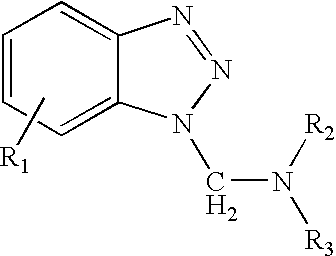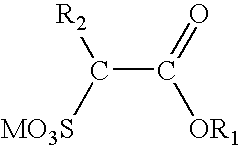Epoxidized ester additives for reducing lead corrosion in lubricants and fuels
a technology of ester additives and additives, applied in the field of fuels, can solve the problems of engine bearings being particularly prone to corrosion, increasing friction, and losing fuel economy
- Summary
- Abstract
- Description
- Claims
- Application Information
AI Technical Summary
Benefits of technology
Problems solved by technology
Method used
Image
Examples
examples
Pb & Cu Corrosion Testing
[0123] The results of a Cummins bench test for measuring the degree of Cu and Pb corrosion of an oil formulation using an American Petroleum Institute (API) Group II base stock are shown in Table 1. The Cummins bench test is part of the API CH-4 category for diesel engine oils. Four metal coupons (25.4 mm squares) of pure lead, copper, tin, and phosphor-bronze are immersed in 100 mL of oil at 121° C. with air bubbling through (5 L / hr) for 168 hours. The used oil is analyzed for metals and the copper sample is examined for discoloration. The limits for API CH-4 are 20 ppm Cu, 120 ppm Pb, 50 ppm Sn in used oil and 3 max for the ASTM D 130 rating of the copper square. Additives were blended into a fully formulated SAE 15W-40 oil with API CI-4 and CH-4 credentials.
[0124] In the first row of Table 1 are data generated on the SAE 15W-40 oil without any top treat of other additives. In the next row is seen the increase in lead corrosion that results from adding ...
PUM
| Property | Measurement | Unit |
|---|---|---|
| temperature | aaaaa | aaaaa |
| weight percent | aaaaa | aaaaa |
| kinematic viscosity | aaaaa | aaaaa |
Abstract
Description
Claims
Application Information
 Login to View More
Login to View More - R&D
- Intellectual Property
- Life Sciences
- Materials
- Tech Scout
- Unparalleled Data Quality
- Higher Quality Content
- 60% Fewer Hallucinations
Browse by: Latest US Patents, China's latest patents, Technical Efficacy Thesaurus, Application Domain, Technology Topic, Popular Technical Reports.
© 2025 PatSnap. All rights reserved.Legal|Privacy policy|Modern Slavery Act Transparency Statement|Sitemap|About US| Contact US: help@patsnap.com



